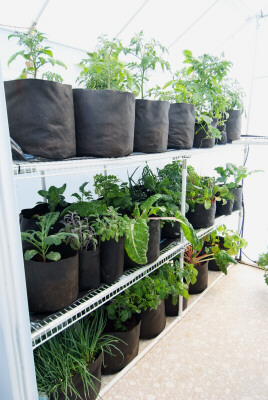Growing More Food in Less Space with a Greenhouse
 With a greenhouse, you don’t have to wait for your frost date to pass to start planting. You can start in the dead of winter to harvest early and late until the fall. Whether you have a large garden or you have limited space, with the right greenhouse you can substantially increase and prolong your harvest and maximize your space.
With a greenhouse, you don’t have to wait for your frost date to pass to start planting. You can start in the dead of winter to harvest early and late until the fall. Whether you have a large garden or you have limited space, with the right greenhouse you can substantially increase and prolong your harvest and maximize your space.
It All Starts with the Seeds
Most seeds require plenty of heat and moisture to germinate. Starting seeds indoors is a great way to get a jump start on spring. Once seedlings establish roots, they are much more equipped to deal with the cool environment of an unheated greenhouse. With limited indoor space, it’s easy to rotate seedlings into the greenhouse making room for the next crop.
It’s also possible to germinate seeds in an unheated greenhouse with bottom heat. Most seeds do not germinate well in cold soil or a cold environment but adding localized heat to the plant’s roots can significantly accelerate growth. A seedling heat mat can provide the necessary heat for development even when the air temperature is low. When the air is cool and roots are heated, the green top growth will be compact with robust root development. If you are anxious to duplicate the rapid growth of later spring, adding just a few degrees to the night time temperature will significantly increase the rate of growth.
For even better growth, supplement natural light with grow lights. Most plants need a minimum of 6 hours of darkness, but outside of this rest period adding more light is beneficial. Plants receiving more light grow faster. Some plants are sensitive to the daylight length and require supplemental light to thrive. Most plants do not require longer day lengths, but nearly all plants benefit from more time to photosynthesize. There is little harm in adding a grow light and a small T-5 grow light is a relatively inexpensive option to purchase and to operate.
Seedlings can be transplanted outdoors as soon as the soil temperature is warm enough. Ideally you will want to wait to plant until soil temperature reach at least 70° for optimal germination. If the major frost danger has passed yet your soil is too cool to plant, a soil heating cable is a good option. These low power draw cables turn on automatically if soil temperature drop below 74°.
In order to reduce transplant shock, which can set a plant back by as much as two weeks, biodegradable Cow Pots are an excellent option. Plant the 4” pots directly into the garden, raised bed or container. The Cow Pot disintegrates eliminating the need to disrupt the plant’s roots. It is also important to harden off your plants whenever you move them from one environment to another; whether it is from your home to the greenhouse or from the greenhouse to your garden.
Grow Food in Container Gardens
One of the biggest trends in gardening in the past few years is gardening in containers. Some people have limited garden space so growing on a patio or porch is a great way to extend the garden. Others choose colorful containers to add accents to their yards. Containers and greenhouses make for a perfect marriage. Planted containers utilizing greenhouse heat grow quickly plus rotating containers in and out of the greenhouse maximizes the decorative effect and prolongs the harvest. Often it is possible to continue harvesting as the plant declines. Plants under stress or nearing the end of their life cycle often become highly productive. Some protection may coax the plant into producing a little longer.
Containers work well in many locations. You will want to place your containers in the conditions required for your plant. Once you identify the plant’s lighting needs, you can place your containers in any area that meets the requirements for your containers. Planters may look nice lining walkways, on steps or decks or placed in boarder or perennial gardens. The Bountiful Container by Rose Marie Nichols McGee & Maggie Stuckey is an excellent resource for growing food in containers. This book provides planting details of many common plants adapted specifically for container growing with combination suggestions and ideas. Nichols Nursery, owned by Rose Marie Nichols, has a nice supply of seeds that work well in containers. Shane Smith’s book, The Greenhouse Gardener’s Companion, provides a wonderful planting schedule. Used in combination, these two books provide all the details you will need to plant something every season.
When planting in containers, soil temperature is not a factor provided you are not sowing the seeds directly in the container. Plants allowed to mature in a greenhouse develop strong roots. Select only high-quality potting soil for containers and make sure to fertilize containers well. An organic mix added to the soil is an excellent option as the material will break down slowly and generally will not burn tender plants as is the risk with some chemical products.
Plant for the Season
One of the most exciting experiences of owning a greenhouse is growing something that could not survive your climate. Blooming lemon trees in February, edible bananas or even coffee are examples of tropical plants grown in greenhouses. If you are interested in growing tropical plants, Logee’s and Stokes Tropicals are excellent sources. You can find them online at www.logees.com and www.stokestropicals.com. Although fun to grow, tropical plants may not be practical if you are more interested in maximum production with limited space. Winter is typically a quiet season in an unheated greenhouse, but it need not be. There are plenty of greens and vegetables that not only will survive the cold but require a cold period for maximum flavor. Many greens started in fall will survive in a greenhouse even when the temperatures are well below freezing. Plants won’t grow much, if at all, when it’s cold, but the existing growth is still available for harvest.
SmartPots are an excellent container choice if production rather than decoration is your objective. SmartPots are fabric containers that allow air flow while holding in heat. These containers are easy to move and have shown growing results similar to raised beds. Containers are easily concealed when placed among other plantings, or can be strategically placed to utilize automatic watering. Areas previously not usable for growing become potential homes to SmartPots. It’s easy to transform even a small rock wall or ledge into a productive space.
Growing Year Round Maximizes your Rewards
Planting seeds creates large yields and has a multiplier effect. Seeds are inexpensive to purchase and can yield a significant crop. When you utilize greenhouse growing space, you increase your return substantially. Additionally, if you use heirloom seeds, you can easily harvest seeds for your next crop for an unlimited supply. Using the vertical space in your greenhouse with benches or hanging rods, doubles or triples the growing area.
An investment in the tools to grow will reap many rewards. Just as seeds produce a bountiful harvest, money spent on the proper tools will increase that reward substantially. Whether you are an experienced grower or you are planting a garden for the first time, using a greenhouse will increase your yield and the fun. If you haven’t purchased any seeds yet, get some today. Planting seeds today is one way to guarantee you will have a better tomorrow. Encourage your neighbors to do the same because nothing brings a community together like sharing food. Now that’s change we can believe in.
Michelle Moore is the General Manager of the Greenhouse Catalog where she has worked with greenhouses for 20 years. Michelle writes and lectures about greenhouse gardening as an Oregon State University Master Gardener and member of Garden Writers Association. Michelle is a Fulbright Scholar and earned an International MBA from Thunderbird, School of Global Management. Michelle and her husband live in Oregon, but they enjoy hints of summer all year in their greenhouse! You can contact Michelle at:






